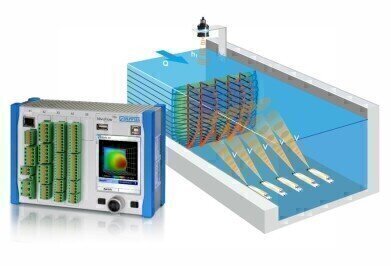Water/wastewater
Calibration Using 5 Flow Sensors Saves the Effort of Extensive Reconstruction Measures
Nov 02 2016
"Abwasserzweckverband Breisgauer Bucht", a municipal association for sewage treatment in the south of Germany, operates a central wastewater treatment plant for its members (29 communities and cities). The WWTP covers a catchment area of 650km² and its treatment capacity is 600.000 population equivalents. The plant is treating wastewater from 375.000 residents as well as from industry and commercial enterprises within the catchment area.
The municipal association requires an accurate flow measurement in the intake of the pre-clarification stage, providing reliable data on approaching water volumes for billing purposes. The measurement spot is located between grit trap and pre-clarification and features significant asymmetric flow conditions due to the structural and operational situation. In the planning stage an inductive mag meter was originally included. Using such a measurement system, however, would have required considerable investment and constructional modification of the measurement site.
As an alternative to installing a mag meter, NIVUS (Germany) proposed the use of three CS2 sensors plus an external level measurement within the rectangular channel of the measurement site. This proposal was accepted by the municipal association. The acquisition of the measurement system following the trial period required compliance with specific provisions: the maximum permissible deviation between the day totals determined in the intake using the NIVUS system and the day totals determined in the outlet of the secondary clarification using a calibrated mag meter was ±3%.
Test measurements covering a period of three months showed that the deviations between the day totals determined using the NIVUS system and the inductive mag meter were almost exclusively within the desired range of ±3%. The installed NIVUS measurement thus achieved the desired quality even at this early stage.
Apart from comparing the measurement results from the three CS2 sensors and the mag meter in the WWTP outlet, the NIVUS measurement was calibrated using the COSP system. COSP is the abbreviation for COrrelation Singularity Profile. The NIVUS COSP technology is a method that permits to calibrate and to adjust flow velocity measurements even under poor flow conditions. This calibration can be carried out based on the cross correlation method using the new NivuFlow 750 M9 transmitter in combination with up to nine flow velocity sensors. During COSP calibration of Forchheim WWTP, 5 CS2 sensors were used. Using these sensors flow velocity profiles could be gained from 16 individual velocities in each of 5 measurement paths with high temporal resolution. These flow velocity profiles then have been evaluated, extended by velocity components found in dead zones and skew flow areas and finally have been interpolated to achieve a two-dimensional flow velocity array. Additionally, the average flow velocity within the investigated flow cross section was determined. Then, the deviations between the average flow velocities coming from the COSP application and the average flow velocities coming from the three-sensors-measurement have been computed. The final evaluation showed that the readings gathered from the solution using three permanent sensors within the intake section are merely 0.7% higher than the average flow velocity determined by the reference measurement using COSP. The measurement was then adjusted accordingly applying the appropriate correction factor.
The result of further comparative measurements over a period of one month was that it is possible to reduce the average deviation between the NIVUS intake measurement and the measurement in the WWTP outlet to less than ±1% by applying the COSP calibration.
Comparative assessment between the flow measurements in intake and outlet sections of the Forchheim WWTP were carried out by "Abwasserzweckverband Breisgauer Bucht". The NIVUS team would like to thank the association for supporting the COSP calibration and for providing the results of the comparison.
COSP calibrations are carried out by the NIVUS GmbH Urban Drainage Monitoring department. Application is recommended for calibration and adjustment of flow measurements installed at measurement sites featuring poor flow conditions (e.g. asymmetric oncoming flow).
Digital Edition
IET 35.2 March
April 2025
Air Monitoring - Probe Sampling in Hazardous Areas Under Extreme Conditions - New, Game-Changing Sensor for Methane Emissions - Blue Sky Thinking: a 50-year Retrospective on Technological Prog...
View all digital editions
Events
Jun 04 2025 Koeln, Germany
Jun 04 2025 Shanghai, China
Jun 08 2025 Denver, CO, USA
Jun 09 2025 Raleigh, NC, USA
Jun 10 2025 Toulouse, France

_1000x1500.jpg)


.jpg)




.jpg)









